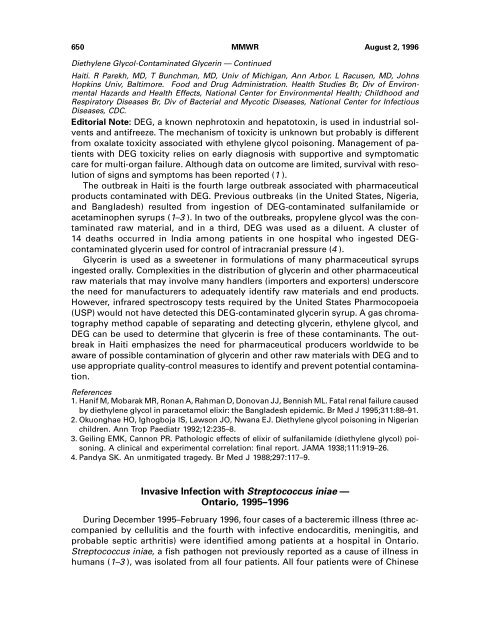Fatalities Associated with Ingestion of Diethylene Glycol ...
Fatalities Associated with Ingestion of Diethylene Glycol ...
Fatalities Associated with Ingestion of Diethylene Glycol ...
You also want an ePaper? Increase the reach of your titles
YUMPU automatically turns print PDFs into web optimized ePapers that Google loves.
650 MMWR August 2, 1996<br />
<strong>Diethylene</strong> <strong>Glycol</strong>-Contaminated Glycerin — Continued<br />
Haiti. R Parekh, MD, T Bunchman, MD, Univ <strong>of</strong> Michigan, Ann Arbor. L Racusen, MD, Johns<br />
Hopkins Univ, Baltimore. Food and Drug Administration. Health Studies Br, Div <strong>of</strong> Environmental<br />
Hazards and Health Effects, National Center for Environmental Health; Childhood and<br />
Respiratory Diseases Br, Div <strong>of</strong> Bacterial and Mycotic Diseases, National Center for Infectious<br />
Diseases, CDC.<br />
Editorial Note: DEG, a known nephrotoxin and hepatotoxin, is used in industrial solvents<br />
and antifreeze. The mechanism <strong>of</strong> toxicity is unknown but probably is different<br />
from oxalate toxicity associated <strong>with</strong> ethylene glycol poisoning. Management <strong>of</strong> patients<br />
<strong>with</strong> DEG toxicity relies on early diagnosis <strong>with</strong> supportive and symptomatic<br />
care for multi-organ failure. Although data on outcome are limited, survival <strong>with</strong> resolution<br />
<strong>of</strong> signs and symptoms has been reported (1 ).<br />
The outbreak in Haiti is the fourth large outbreak associated <strong>with</strong> pharmaceutical<br />
products contaminated <strong>with</strong> DEG. Previous outbreaks (in the United States, Nigeria,<br />
and Bangladesh) resulted from ingestion <strong>of</strong> DEG-contaminated sulfanilamide or<br />
acetaminophen syrups (1–3 ). In two <strong>of</strong> the outbreaks, propylene glycol was the contaminated<br />
raw material, and in a third, DEG was used as a diluent. A cluster <strong>of</strong><br />
14 deaths occurred in India among patients in one hospital who ingested DEGcontaminated<br />
glycerin used for control <strong>of</strong> intracranial pressure (4 ).<br />
Glycerin is used as a sweetener in formulations <strong>of</strong> many pharmaceutical syrups<br />
ingested orally. Complexities in the distribution <strong>of</strong> glycerin and other pharmaceutical<br />
raw materials that may involve many handlers (importers and exporters) underscore<br />
the need for manufacturers to adequately identify raw materials and end products.<br />
However, infrared spectroscopy tests required by the United States Pharmocopoeia<br />
(USP) would not have detected this DEG-contaminated glycerin syrup. A gas chromatography<br />
method capable <strong>of</strong> separating and detecting glycerin, ethylene glycol, and<br />
DEG can be used to determine that glycerin is free <strong>of</strong> these contaminants. The outbreak<br />
in Haiti emphasizes the need for pharmaceutical producers worldwide to be<br />
aware <strong>of</strong> possible contamination <strong>of</strong> glycerin and other raw materials <strong>with</strong> DEG and to<br />
use appropriate quality-control measures to identify and prevent potential contamination.<br />
References<br />
1. Hanif M, Mobarak MR, Ronan A, Rahman D, Donovan JJ, Bennish ML. Fatal renal failure caused<br />
by diethylene glycol in paracetamol elixir: the Bangladesh epidemic. Br Med J 1995;311:88–91.<br />
2. Okuonghae HO, Ighogboja IS, Lawson JO, Nwana EJ. <strong>Diethylene</strong> glycol poisoning in Nigerian<br />
children. Ann Trop Paediatr 1992;12:235–8.<br />
3. Geiling EMK, Cannon PR. Pathologic effects <strong>of</strong> elixir <strong>of</strong> sulfanilamide (diethylene glycol) poisoning.<br />
A clinical and experimental correlation: final report. JAMA 1938;111:919–26.<br />
4. Pandya SK. An unmitigated tragedy. Br Med J 1988;297:117–9.<br />
<strong>Diethylene</strong> <strong>Glycol</strong>-Contaminated Glycerin — Continued<br />
Invasive Infection <strong>with</strong> Streptococcus iniae —<br />
Ontario, 1995–1996<br />
During December 1995–February 1996, four cases <strong>of</strong> a bacteremic illness (three accompanied<br />
by cellulitis and the fourth <strong>with</strong> infective endocarditis, meningitis, and<br />
probable septic arthritis) were identified among patients at a hospital in Ontario.<br />
Streptococcus iniae, a fish pathogen not previously reported as a cause <strong>of</strong> illness in<br />
humans (1–3 ), was isolated from all four patients. All four patients were <strong>of</strong> Chinese
















